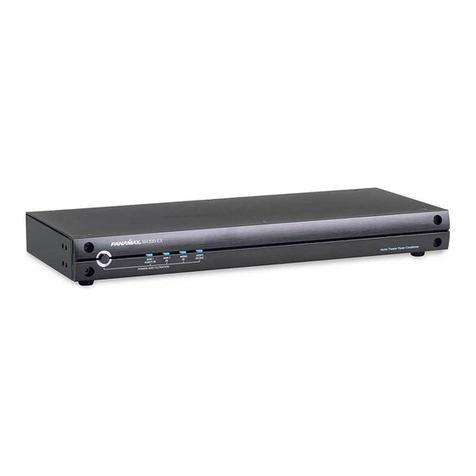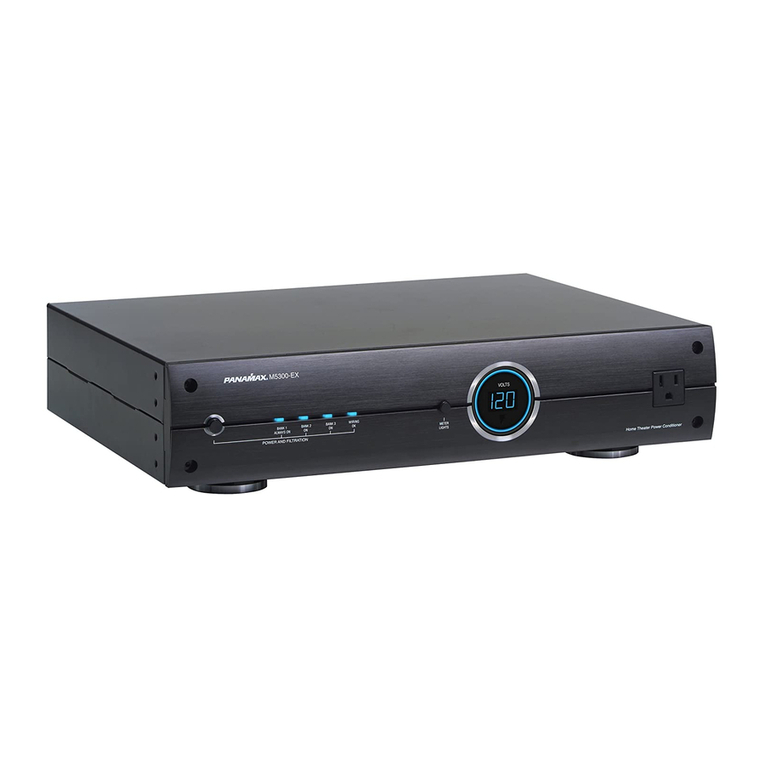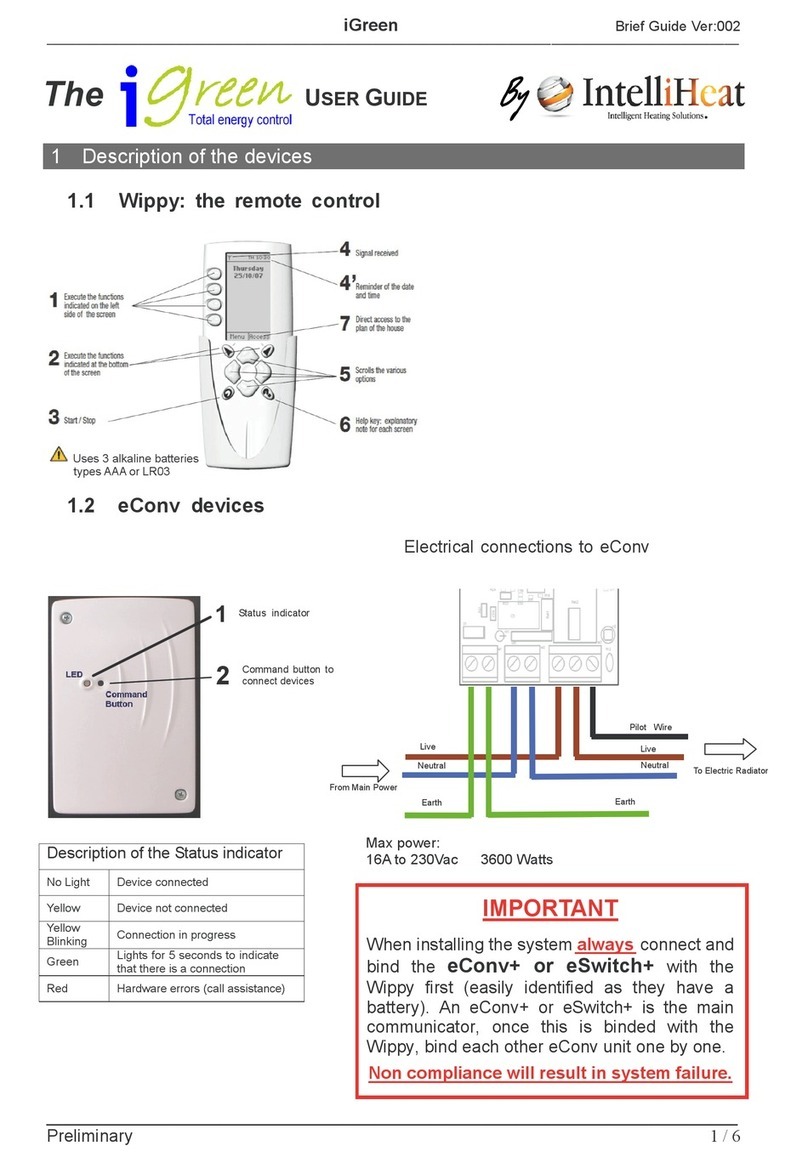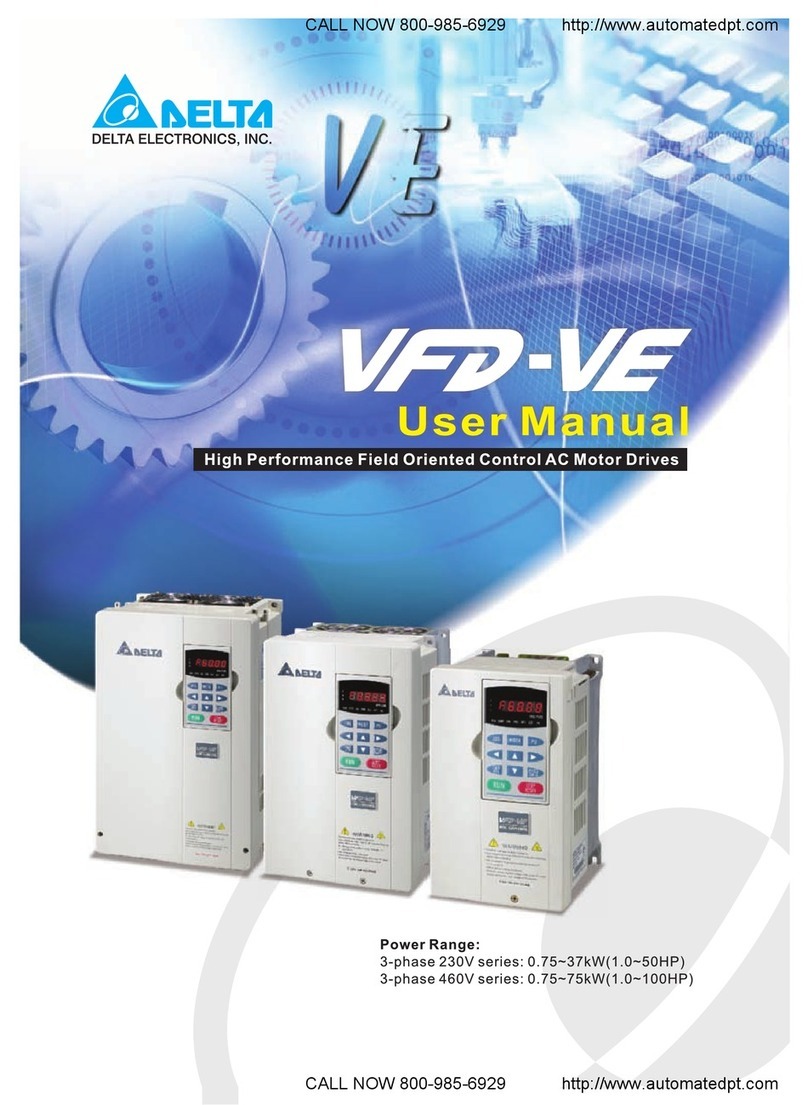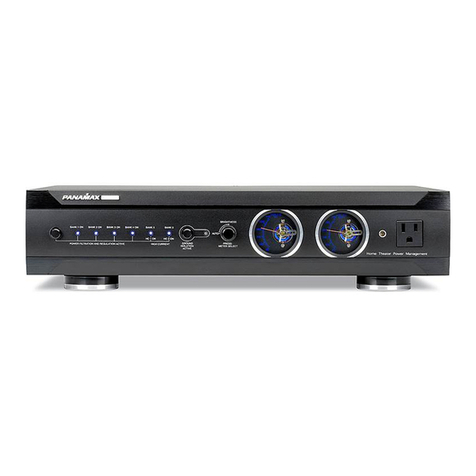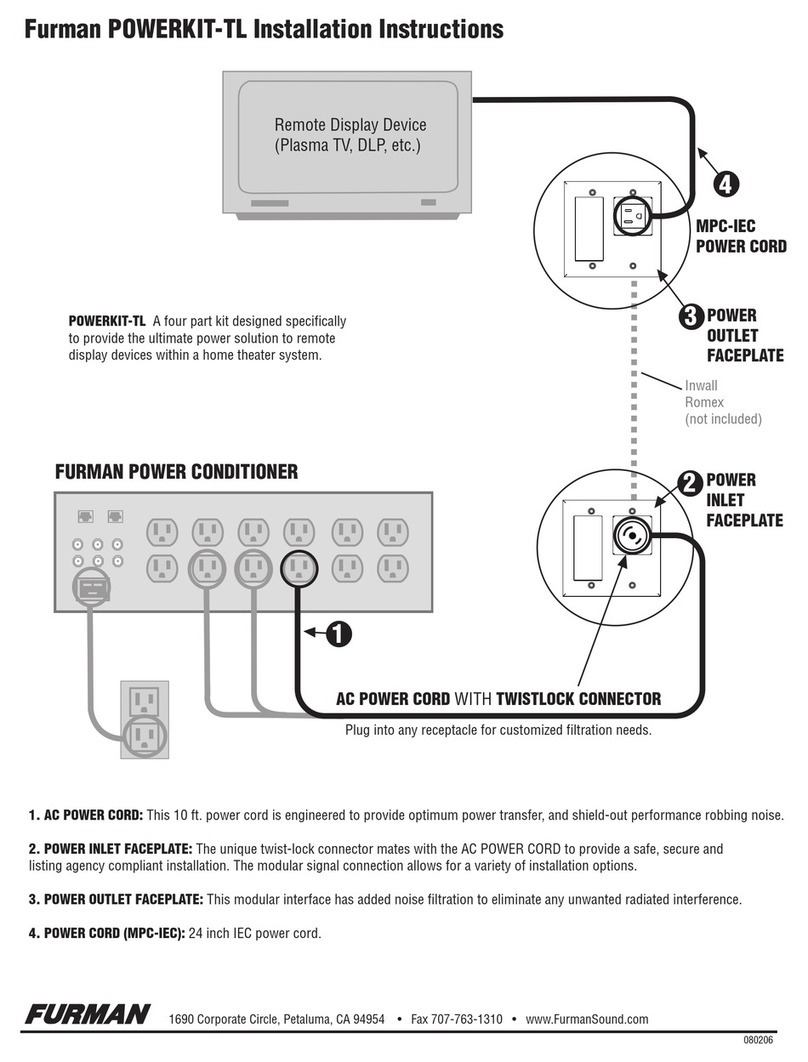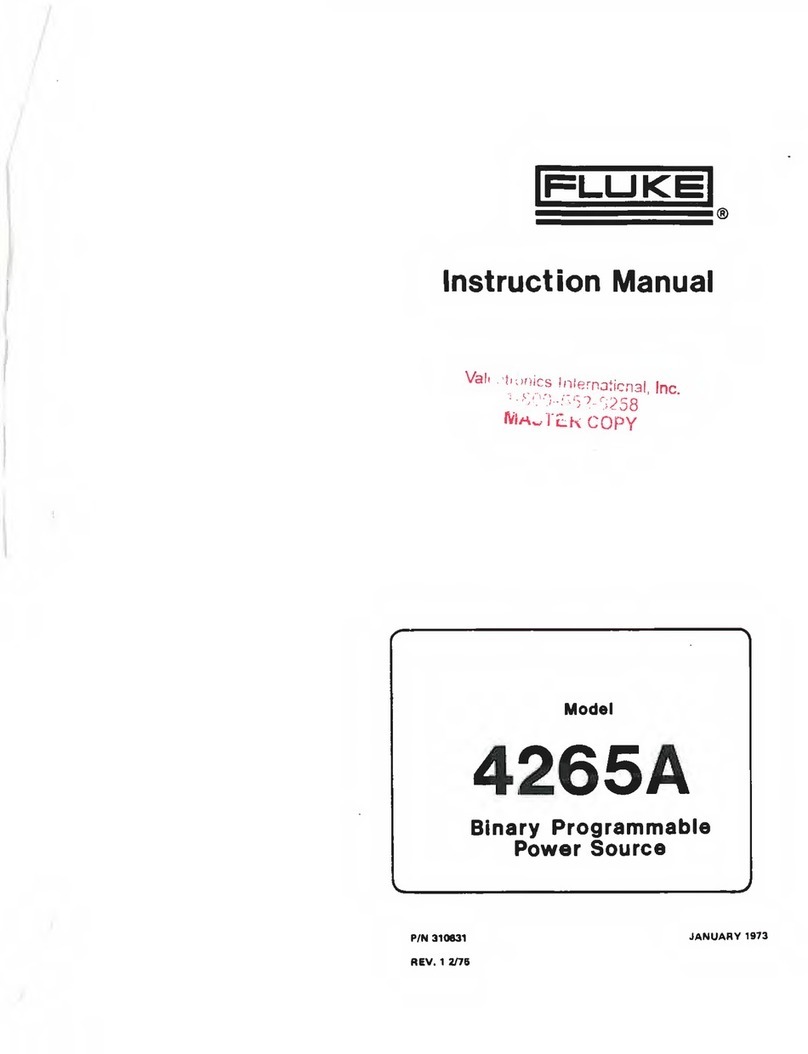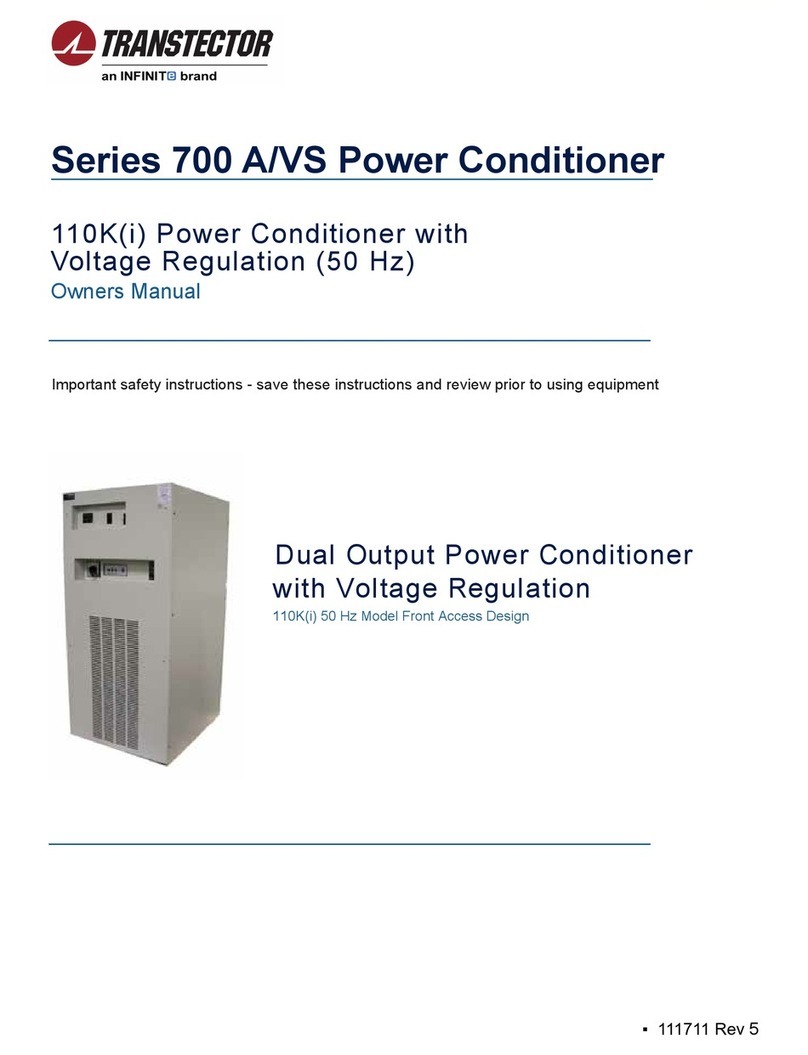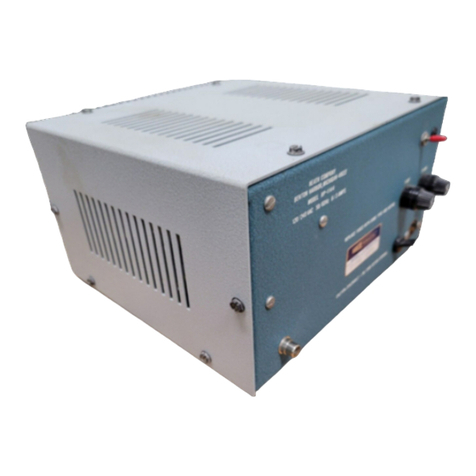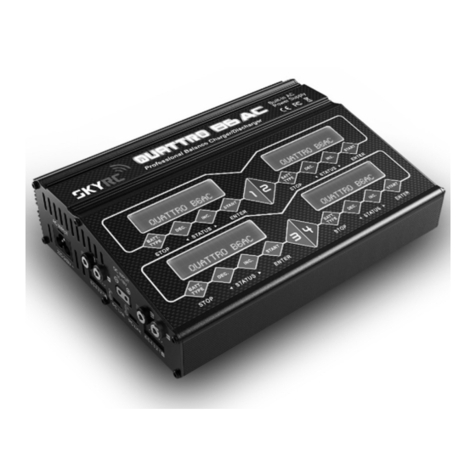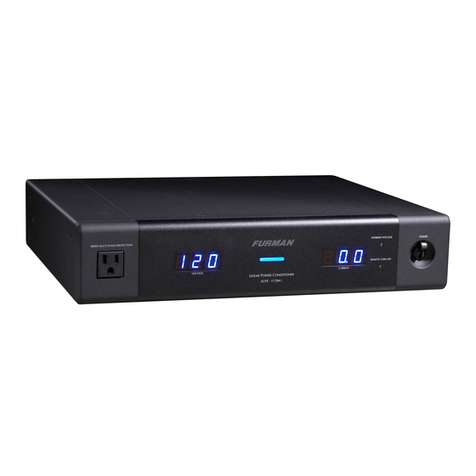Good Will Instrument GKP-2302 User manual

Programmable AC/DC Power Source
GKP-2302
USER MANUAL
GW INSTEK PART NO. 82KP-23020M01
ISO-9001 CERTIFIED
MANUFACTURER

This manual contains proprietary information, which is protected by copyrights. All rights are reserved.
No part of this manual may be photocopied, reproduced or translated to another language without prior
written consent of Good Will company.
The information in this manual was correct at the time of printing. However, Good Will continues to
improve products and reserves the rights to change specification, equipment, and maintenance
procedures at any time without notice.
Good Will Instrument Co., Ltd.
No. 7-1, Jhongsing Rd., Tucheng Dist., New Taipei City 236, Taiwan.

i
Preface
Thank you for purchasing our Programmable AC/DC Power Source GKP-2303.
For safe and correct use of the electrical product, please first read "Safety Precautions" on the
next page.
Alert symbols in this manual
This manual uses the following alert symbols. The instructions by these alert symbols shall be
carefully obeyed to ensure equipment operator's safety and prevent damage to equipment.
Equipment handling could result in death or serious injury. This symbol contains information to
avoid such risk.
Equipment handling could result in minor or moderate injury, or property damage. This symbol
contains information to avoid such risk.
This manual consists of the following chapters.
If it is the first time for you to use this product, start with "1. Outline."
1. Outline: Explains the overview, configuration, and features of this product.
2. Preparation before Use: Explains the preparations carried out before installation or
operation.
3. Basic operation: Explains the component names and basic operations.
4. Advanced Operation: Explains the operations more extensively.
5. Description of Screen and Menu: Explains the screen configuration and menu composition.
6. Remote Control: Explains the remote control via communication interface.
7. Options: Explains the available options.
8. Troubleshooting: Explains the remedies when an error message is displayed, or when a
failure is suspected.
9. Maintenance: Explains the methods of storage, repackaging, transportation, and
maintenance.
10. Specifications: Provides the list of specifications of functions and performance.
CAUTION
WARNING

ii
Safety Precautions
For safe use, ensure to obey the following warnings and considerations.
We are not responsible for damage resulting from failure to obey these warnings and
considerations.
This product is an insulation Class I device (with a protective conductor terminal) complying
with the JIS and IEC standards.
Ensure you obey the instructions in this instruction manual.
This instruction manual contains instructions for safe operation and use of this product.
Before using the product, please read this manual first.
All the warning items contained in this instruction manual are intended for preventing risks
that may lead to serious accidents. Ensure to obey them.
Ensure to ground.
This product uses a line filter, which may cause electric shock if the product is not grounded.
To prevent electric shock accidents, connect it to an earth ground so that ground resistance is
100or less.
Check the power supply voltage.
This product operates on the power supply voltage specified in "
2.4 Grounding and Power
Connections
". Before connecting the product to a power supply, make sure that the voltage of
distribution board conforms to the power supply voltage rating of the product.
If you notice anything strange
If this product produces smoke, unusual odor, or strange sound, immediately cut the power to
the product and stop using it.
Should you encounter any anomaly like above, immediately contact us or our agent. Never use
it until the repair is completed.
Do not use in a gaseous atmosphere.
This may pose a risk of explosion or other.
Do not remove the cover.
This product has high-voltage portions inside. Never remove the cover.
When inspection into the inside of the product is needed, never allow anybody to touch the
innards except our certified service engineers.
Do not modify the product.
Never modify the product. Modification to the product may pose a new risk. We may refuse the
repair of a modified product at fault.

iii
Prevention of electric shock by output voltage
The maximum output of this product is ± 440 V. Be careful to avoid electric shock. Directly
touching the output or changing the cable connection while the output is on may cause electric
shock.
This product weights over 18 kg.
Do not carry it alone, or you may suffer physical injury.
Safety symbols
The following shows the general definitions of the safety symbols used on the product main
unit and in the instruction manual.
Refer to the instruction manual
This notifies the user of potential hazards and indicates that he/she must refer to
the instruction manual.
Electric shock hazard
This indicates that an electric shock may occur under specific conditions.
Protection conductor terminal
This indicates that the terminal needs to be grounded in order to prevent electric
shock accidents.
Before operating the equipment, ensure to connect this terminal to an earth ground
by the "Electric Facilities Technical Standards Type D (100or less)" or a higher
standard.
Warning
This contains information to avoid risks in equipment handling that could
result in loss of life or bodily injury (e.g., electric shock).
Caution
This contains information to avoid damage to the equipment in equipment
handling.
Other symbols
Chassis
This indicates that the terminal (or external conductor for a connector) is connected
to the chassis.
Request about disposal
For environmental preservation, pay attention to the following when you dispose of this
product.
The backlight of the LCD contains mercury.
This product shall be disposed of through an appropriate industrial waste disposer.
CAUTION
WARNING

iv
Table of Contents
Page
Preface .................................................................................................................................................i
Safety Precautions ...............................................................................................................................ii
List of Figures.....................................................................................................................................ix
List of Tables ......................................................................................................................................xi
1. OUTLINE.......................................................................................................................................1
1.1 Overview ..............................................................................................................................2
1.2 Features ...............................................................................................................................2
2. PREPARATIONS BEFORE USE ........................................................................................................3
2.1 Check Before Use..................................................................................................................4
2.2 About Installation Environment .............................................................................................4
2.3 Precautions for Moving and Transportation ............................................................................6
2.4 Grounding and Power Connections ........................................................................................7
2.5 Output and System Cable Connection ..................................................................................11
2.6 How to Tilt Control Panel ....................................................................................................12
2.7 Simple Operation Check......................................................................................................13
2.8 Calibration..........................................................................................................................16
3. BASIC OPERATION ......................................................................................................................17
3.1 Component Name ..............................................................................................................18
3.1.1 Front ..........................................................................................................................18
3.1.2 Rear............................................................................................................................19
3.1.3 Control Panel ..............................................................................................................20
3.2 Power On/Off .....................................................................................................................21
3.2.1 Before Turning on the Power........................................................................................21
3.2.2 Power On....................................................................................................................21
3.2.3 Screen Display and Operations at Starting Up...............................................................21
3.2.4 The Settings Loaded after Startup ................................................................................22
3.2.5 Checking the Rated Power............................................................................................22
3.2.6 Power Off....................................................................................................................22
3.3 Basic Key Operations ..........................................................................................................23
3.3.1 Changing the Output Function (Continuous Output/Sequence/Simulation) ................23
3.3.2 Item Selection .............................................................................................................23
3.3.3 Using Soft-keys ...........................................................................................................24
3.3.4 Closing Windows.........................................................................................................25
3.3.5 Entering Values (Numerical Entry Box) .........................................................................26
3.3.6 Entering Strings (Character String Entry Box) ................................................................27
3.3.7 Using Shortcut Operations (SHIFT Key) .......................................................................27
3.4 Using the Continuous Function ...........................................................................................28

v
3.4.1 Setting the AC/DC Mode and the Signal Source ............................................................28
3.4.2 Setting the Output Range ............................................................................................32
3.4.3 Setting Waveforms ......................................................................................................33
3.4.4 Setting the Output Voltage (Single-phase Output).........................................................35
3.4.5 Setting the Output Frequency ......................................................................................37
3.4.6 Setting the Output On/Off Phase .................................................................................37
3.4.7 Turning the Output On or Off ......................................................................................38
3.4.8 Using the Measurement Function ................................................................................38
3.4.9 Switching the Display Format (RMS/AVG/Peak) of the Measured Value .........................39
3.4.10 Enlarge Display Letters for the Measured Value.............................................................41
3.4.11 Clearing the Output Current Peak-hold Value ................................................................43
4. ADVANCED OPERATION .............................................................................................................47
4.1 Using the Limiter, Setting the Limiter ...................................................................................48
4.1.1 Use the Peak Current Limiter .......................................................................................48
4.1.2 Using the RMS Current Limiter ....................................................................................50
4.1.3 Using the Voltage Setting Range Limit ..........................................................................51
4.1.4 Using the Frequency Setting Range Limit ......................................................................53
4.1.5 About the Wattage Limiter ...........................................................................................54
4.2 Using the Sequence Function ..............................................................................................55
4.2.1 Basics .........................................................................................................................55
4.2.2 Sequence Function Parameters ....................................................................................57
4.2.3 Example of Output Using Sequence Function ...............................................................60
4.2.4 Process Flow in a Step .................................................................................................61
4.2.5 Edit a Sequence...........................................................................................................62
4.2.6 Load a Sequence .........................................................................................................64
4.2.7 Execute a Sequence .....................................................................................................67
4.2.8 Save a Sequence..........................................................................................................71
4.2.9 Clear/Rename Sequence ..............................................................................................75
4.2.10 Set so as the Sequence Function is Selected at Power-on...............................................79
4.2.11 Sequence Control by External Control ...........................................................................80
4.2.12 Screen Overview..........................................................................................................80
4.3 Using Power Fluctuation Testing (Simulation) Function ........................................................82
4.3.1 Basics .........................................................................................................................82
4.3.2 Simulation Function Parameters ..................................................................................83
4.3.3 Output Examples Using Simulation Function................................................................85
4.3.4 Process Flow in a Step .................................................................................................87
4.3.5 Editing Simulation.......................................................................................................88
4.3.6 Loading a Simulation...................................................................................................90
4.3.7 Executing Simulation ...................................................................................................94
4.3.8 Saving Simulation .......................................................................................................96
4.3.9 Clear/Rename Simulation ..........................................................................................100
4.3.10 Set so as the Simulation Function is Selected at Power-on...........................................104

vi
4.3.11 Simulation Control by External Control .......................................................................104
4.3.12 Screen Overview........................................................................................................105
4.4 Measuring Harmonic Current ............................................................................................106
4.4.1 Harmonic current......................................................................................................106
4.4.2 Basics .......................................................................................................................107
4.4.3 Measured Value Display Method ................................................................................107
4.5 Measuring Inrush Current .................................................................................................108
4.5.1 Inrush Current ..........................................................................................................108
4.5.2 Basics .......................................................................................................................109
4.5.3 Measurement Method ...............................................................................................109
4.5.4 Measurement Tips ....................................................................................................110
4.6 Using Clipped Sine Wave...................................................................................................110
4.7 Outputting Arbitrary Waveform..........................................................................................114
4.7.1 Basics .......................................................................................................................114
4.7.2 Arbitrary Waveform Creation Procedure ......................................................................114
4.7.3 Arbitrary Waveform Creation Example ........................................................................114
4.7.4 Transferring Arbitrary Waveform ................................................................................114
4.7.5 Outputting Arbitrary Waveform ..................................................................................118
4.8 Using Memory Function ....................................................................................................119
4.8.1 Basic Setting Memory................................................................................................120
4.8.2 Arbitrary Waveform Memory ......................................................................................128
4.8.3 Sequence Memory .....................................................................................................132
4.8.4 Simulation Memory ...................................................................................................133
4.9 Using USB Memory Function ............................................................................................134
4.10 Using Monitor Function ....................................................................................................135
4.11 Using Remote Sensing Function ........................................................................................137
4.12 Using AGC Function .........................................................................................................139
4.13 Using Autocal Function .....................................................................................................142
4.14 Adjusting DC Offset ..........................................................................................................146
4.15 Using as DC Power Supply ................................................................................................147
4.16 Setting Voltage using External DC Input Signal ...................................................................148
4.16.1 Using External Signal in AC-VCA Mode.......................................................................149
4.16.2 Using External Signal in DC-VCA Mode ......................................................................151
4.17 Control Using External Control Function ............................................................................152
4.18 Synchronizing the Output Frequency with the Power Line or the External Signal ...................157
4.19 Amplifying the External Signal Input .................................................................................158
4.20 Turning the Output On or Off Rapidly ................................................................................160
4.21 Enabling Automatic Output-On at Power-On......................................................................161
4.22 Using the Emission CO2Calculator ....................................................................................163
4.23 Power Unit Energization Setting (Using Under the Restricted Rated Power) .........................164
4.24 Key Lock ...........................................................................................................................167
4.25 Beep ................................................................................................................................167

vii
4.26 Changing the Background Color and the Contrast of the Screen ..........................................168
4.27 Restoring to the Factory Default Setting (Reset)..................................................................169
5. DESCRIPTION OF SCREEN AND MENU.....................................................................................173
5.1 Screen Configuration.........................................................................................................174
5.1.1 Status Icon................................................................................................................175
5.1.2 Measured Value Display Items ...................................................................................176
5.1.3 Output Setting Display Items .....................................................................................176
5.1.4 Warning and Error Display .........................................................................................177
5.2 Menu Composition ...........................................................................................................177
5.2.1 Menus of the Continuous Function ............................................................................177
5.2.2 Menus of the Sequence Function ...............................................................................178
5.2.3 Menus of the Simulation Function .............................................................................179
5.2.4 Menus of the Memory Function .................................................................................179
5.2.5 System Menus ..........................................................................................................180
6. REMOTE CONTROL...................................................................................................................181
6.1 Communication Interface ..................................................................................................182
6.1.1 USB ..........................................................................................................................182
6.1.2 RS232 .......................................................................................................................184
6.1.3 GPIB.........................................................................................................................186
6.2 Remote/Local State Switching ...........................................................................................188
6.2.1 Remote State ............................................................................................................188
6.2.2 Local State ................................................................................................................188
7. TROUBLESHOOTING ................................................................................................................189
7.1 Error Messages and Error Handling ...................................................................................190
7.1.1 Error Message Screen ................................................................................................190
7.1.2 If An Error Message is Displayed ................................................................................190
7.1.3 If An Error Occurs Repeatedly ....................................................................................191
7.1.4 Protection Operation Types .......................................................................................192
7.1.5 Error Message List ....................................................................................................193
7.2 When a Failure is Suspected ..............................................................................................196
8. MAINTENANCE.........................................................................................................................203
8.1 Preface .............................................................................................................................204
8.2 Daily Maintenance ............................................................................................................204
8.3 Storage, Repackaging, Transportation ................................................................................206
8.4 Checking Firmware Version ...............................................................................................206
9. SPECIFICATIONS .......................................................................................................................209
9.1 Output Function ...............................................................................................................210
9.2 Output Range ...................................................................................................................210
9.3 AC/DC Mode ....................................................................................................................210
9.4 Signal Source....................................................................................................................211
9.5 AC Output ........................................................................................................................212
9.6 DC Output........................................................................................................................213

viii
9.7 Output Voltage Stability ....................................................................................................214
9.8 Distortion of Output Voltage Waveform .............................................................................214
9.9 Power Input......................................................................................................................214
9.10 Withstand Voltage and Insulation Resistance .....................................................................215
9.11 Measurement Function .....................................................................................................215
9.12 Power Unit Energization Setting ........................................................................................217
9.13 Current Limiter .................................................................................................................218
9.14 Setting Range Limit Function.............................................................................................218
9.15 Remote Sensing................................................................................................................219
9.16 AGC .................................................................................................................................219
9.17 Autocal (Output Voltage Compensation)............................................................................220
9.18 Sequence..........................................................................................................................221
9.19 Simulation........................................................................................................................221
9.20 Clipped Sine Wave ............................................................................................................222
9.21 Arbitrary Wave ..................................................................................................................223
9.22 External Signal Input .........................................................................................................223
9.22.1 External Synchronous Signal Input (Signal Source SYNC only) .....................................223
9.22.2 Voltage Setting Signal Input (Signal Source VCA only).................................................223
9.22.3 External Signal Input (only EXT and ADD) ..................................................................224
9.23 General Function ..............................................................................................................224
9.24 Memory Function..............................................................................................................225
9.25 Self-diagnosis/Protection Function ....................................................................................226
9.26 External Control I/O ..........................................................................................................227
9.27 External Interface ..............................................................................................................227
9.28 USB Memory Interface ......................................................................................................228
9.29 Waveform Monitor Output ................................................................................................228
9.30 Safety and EMC ................................................................................................................229
9.31 Operation Environment.....................................................................................................229
9.32 Externals, Weight, and Terminal Block ................................................................................230
9.33 Option .............................................................................................................................230
9.34 Outline Dimensional Drawing ...........................................................................................231
Index...............................................................................................................................................232

ix
Figures and Tables
List of Figures
Page
Figure 2-1 How to Use the Adjuster Foot ...............................................................................................5
Figure 3-1 Component Name (Front) ..................................................................................................18
Figure 3-2 Component Name (Rear) ...................................................................................................19
Figure 3-3 Component Name (Control Panel) ......................................................................................20
Figure 3-4 The Rated Power Icon.........................................................................................................22
Figure 3-5 The Root Menu ..................................................................................................................23
Figure 3-6 The Example of a Selection Box...........................................................................................24
Figure 3-7 An Example of a Data List Box ............................................................................................24
Figure 3-8 Soft-key Function ...............................................................................................................25
Figure 3-9 An Example of a Window with a [Close] Button ....................................................................25
Figure 3-10 The Example of the Window with the [OK]/[Cancel] Button .................................................26
Figure 3-11 A Numerical Entry Box......................................................................................................26
Figure 3-12 Character String Entry Box ................................................................................................27
Figure 3-13 The Normal View (left) and the Simple View Mode (right) ..................................................41
Figure 4-1 Step-control Parameters and intra-Step Parameters .............................................................56
Figure 4-2 Step Behavior ....................................................................................................................57
Figure 4-3 Stop Phase ........................................................................................................................60
Figure 4-4 Example of Sequence .........................................................................................................60
Figure 4-5 Process Flow in Sequence Step ...........................................................................................61
Figure 4-6 Branch Operation/Stop Operation ......................................................................................62
Figure 4-7 Sequence Edit View ............................................................................................................81
Figure 4-8 Sequence Control View (Output Off State) ..........................................................................81
Figure 4-9 Sequence Control View (Output On State/Sequence in Execution) ........................................81
Figure 4-10 Sequence Control View (Output On State/Sequence Stopped) ............................................82
Figure 4-11 Simulation Function Steps ................................................................................................84
Figure 4-12 Voltage Dip Simulation Example .......................................................................................86
Figure 4-13 Voltage Change Simulation Example..................................................................................86
Figure 4-14 Process Flow through Simulation Steps .............................................................................87
Figure 4-15 Stop Operation ................................................................................................................87
Figure 4-16 Simulation Edit View ......................................................................................................105
Figure 4-17 Simulation Control View (Output Off State, Simulation Stopped) .....................................105
Figure 4-18 Simulation Control View (Output On State, Simulation Running) .....................................106
Figure 4-19 Simulation Control View (Output On State, Simulation Stopped) .....................................106
Figure 4-20 Current Waveform Containing Many Harmonic Components ............................................107
Figure 4-21 Inrush Current Example ..................................................................................................109
Figure 4-22 Clipped Sine Wave..........................................................................................................111

x
Figure 4-23 USB Memory Folder Structure.........................................................................................134
Figure 4-24 The Message Window to be Shown Before the Automatic Output-On After the Power-On ..162
Figure 5-1 Component Name (Display Areas on the Screen) ..............................................................174
Figure 5-2 Menu Composition ..........................................................................................................177
Figure 7-1 Error Message Screen Example .........................................................................................190
Figure 9-1 Range of Ambient Temperature/Humidity .........................................................................230
Figure 9-2 Outline Dimensional Drawing...........................................................................................231

xi
List of Tables
Page
Table 2-1 List of Contents .....................................................................................................................4
Table 2-2 Heat Value (Estimate at Power Input 200 V, Rated Output) ......................................................4
Table 2-3 Weight ..................................................................................................................................5
Table 2-4 Power Input Terminal .............................................................................................................8
Table 2-5 Maximum Input Power/Current and Power Input Cable Gauge .................................................9
Table 2-6 Output Terminals.................................................................................................................11
Table 3-1 Component Name (Front) ....................................................................................................18
Table 3-2 Component Name (Rear) .....................................................................................................19
Table 3-3 Component Name (Control Panel)........................................................................................20
Table 3-4 How the Rated Power Icon is Displayed Depending on the Power Unit Energization Setting ....22
Table 3-5 Character String Entry List....................................................................................................27
Table 3-6 Shortcut Operations ............................................................................................................27
Table 3-7 Description of the AC/DC Mode ...........................................................................................28
Table 3-8 The Description of the Signal Source ....................................................................................29
Table 3-9 List of the Selectable Combinations of the AC/DC Mode and the Signal Source ......................29
Table 3-10 The Setting Range per Output Range ..................................................................................32
Table 3-11 Main Measurement Functions ............................................................................................38
Table 3-12 The Measuring Mode for the Measured Values of the Output Voltage and Output Current .....39
Table 4-1 Wattage Limiter Value per Phase (Reference value) ................................................................54
Table 4-2 Parameters of Sequence Function .........................................................................................57
Table 4-3 Example of Editing Sequence................................................................................................60
Table 4-4 Simulation Function Parameters ...........................................................................................83
Table 4-5 Simulation Function Steps and Settable Step Parameters.......................................................84
Table 4-6 Voltage Dip Simulation Edit Example ....................................................................................86
Table 4-7 Voltage Change Simulation Edit Example ..............................................................................87
Table 4-8 Different Output Voltage Settings Depending on Clip Depth Setting Method ........................111
Table 4-9 Content Saved in Sequence Memory ...................................................................................132
Table 4-10 Content Saved in Simulation Memory ...............................................................................133
Table 4-11 Setting Range of DC Offset Adjustment Value....................................................................146
Table 4-12 CONTROL I/O Pin Assignment ........................................................................................153
Table 4-13 The Output Terminal Impedance (Reference Values in the Rear Output Terminal) in the Output
Off State when the Activation of the Output Relay is Disabled ......................................160
Table 4-14 Setting Items to be Reset..................................................................................................169
Table 5-1 Component Name (Display Areas on the Screen) ................................................................174
Table 5-2 Status Icons ......................................................................................................................175
Table 5-3 Measured Value Display Items............................................................................................176
Table 5-4 Output Setting Display Items .............................................................................................176
Table 5-5 Menus of the Continuous Function .....................................................................................177
Table 5-6 Menus of the Sequence Function ........................................................................................178
Table 5-7 Menus of the Simulation Function ......................................................................................179

xii
Table 5-8 Menus of the Memory Function ..........................................................................................179
Table 5-9 System Menus...................................................................................................................180
Table 7-1 Description of the Error Message Screen ............................................................................190
Table 7-2 Error Message List.............................................................................................................193
Table 7-3 Actions When a Failure is Suspected ...................................................................................196

1
1. OUTLINE
1.1 Overview ···················································································· 2
1.2 Features ····················································································· 2

GKP-2302 User Manual
2
1.1 Overview
The programmable AC/DC Power Source GKP-2303 offers a compact, lightweight, and
highly-efficient power system. It also provides various interfaces such as the external control
input/output and communication interface to address a wide variety of uses.
1.2 Features
Various interfaces to address a variety of uses
In addition to the RS232, USB, and GPIB interfaces for remote control from a computer or
sequencer, a contact/TTL signal can be used to turn the output on/off or switch the memory
without using a computer. The GKP-2303 also provides a status output for showing the device
status and output which is synchronized with Sequence or Simulation steps. These functions
allow you to achieve various levels of systemization and automatization. The AGC function and
Autocal function is also provided to compensate for any drop in output voltage.
Variable current limiter
This function can limit the effective value and the positive/negative peak value of the output
current where the limiting value is variable. You can set the limiter so that the output is turned
off when the limited condition continues for a certain time.
Globally adjustable power inlet without restriction by the power supply environment
GKP-2303 supports a wide range of power input from 100 V to 230 V.
Feature-rich measurement functions
On the panel, the GKP-2303 displays the effective value, peak value, average DC value, current
peak-hold value, and active/apparent power of the output voltage/current, the power factor,
crest factor, reactive power, and harmonic current.
USB memory support
You can write/read the following data to/from a commercial USB memory stick:
Basic settings
Sequences
Simulations
Arbitrary waveforms
Restriction of CO2emission (= power usage) and the display of CO2emission (=
power usage) during operation
By using switching amplifiers, efficiency is improved by about 27% compared to linear
amplifiers. When the power output is low, the internal loss can be lowered by reducing the
number of power units being powered on. A function for calculating and displaying the CO2
emission from internal losses or from output power is also included.

3
2. PREPARATIONS BEFORE USE
2.1 Check Before Use······································································· 4
2.2 About Installation Environment ················································ 4
2.3 Precautions for Moving and Transportation ····························· 6
2.4 Grounding and Power Connections ·········································· 7
2.5 Output and System Cable Connection ···································· 11
2.6 How to Tilt Control Panel ························································ 12
2.7 Simple Operation Check·························································· 13
2.8 Calibration················································································ 16

GKP-2302 User Manual
4
2.1 Check Before Use
Check the safety.
To ensure equipment operator's safety, be sure to read the following sections of the instruction
manual at the beginning.
Safety Precautions
(Page ii)
2.4 Grounding and Power Connections
(page 7)
Check the appearance and contents.
If there is any problem, contact the seller (GW Instek or a licensed distributor) from whom you
purchased the product.
Appearance check
Make sure that there is no damage or dents made during the transportation on the LCD
screen, keys, jog, shuttle, or rear connectors.
Contents (main unit and accessories) check
The contents are listed in Table 2-1. Make sure that the main unit and the accessories are
included.
Table 2-1 List of Contents
Contents
Quantity
Main unit
Main Unit
1
Accessories
CD-ROM
User Manual
Programming Manual
LabView Driver
1
Power Cable (3m approx.)
1
2.2 About Installation Environment
To safely use the instrument and to maintain reliability, take the following into consideration:
Install the product where the exhaust heat will not damage surroundings.
This product performs forced air cooling using a fan. Keep the front air inlet and rear air
outlet away from walls with a clearance of at least 50 cm to allow for adequate air
circulation.
This product exhausts the heat from the air outlet on the rear. Do not place heat-sensitive
objects around the outlet.
If you install the product in a closed narrow room, air conditioning equipment is required.
The heat value of this product is shown in Table 2-2 (estimate at power input 200 V, rated
output).
Table 2-2 Heat Value (Estimate at Power Input 200 V, Rated Output)
Rated output
Heat value
GKP-2303
3 kVA
0.9 kW
780 kcal/h

2.2 About Installation Environment
5
Install the product on a sturdy place.
The floor needs to have enough strength to support the weight of the product. The weight
of this product is shown in Table 2-3.
Table 2-3 Weight
Weight
GKP-2303
50 kg approx.
Do not install this product on a sloped surface. The Adjuster Foot is only for temporary
fixing, and cannot support the unit's own weight. You also must not lean on this product
or use it as a support. How to use the Adjuster Foot is shown in Figure 2-1.
Adjuster Foot
The Adjuster Foot can be moved
up by turning it to left
(counterclockwise) as viewed from
above, and moved down by turning
it to right (clockwise). Move the
Adjuster Foot down by using a
spanner (19 mm diameter).
Down
Up
Figure 2-1 How to Use the Adjuster Foot
About arrangement
Do not place the product on its side or back.
Do not stack the product on top of another unit, or place it in front of or behind another
unit (such an arrangement makes the unit behind inhale the exhaust heat of the other).
Other installation location conditions
Use the product indoors, at altitudes of up to 2000 m.
Use the product where the temperature is between 0˚C to +50˚C, and the humidity is
between 5% to 85% RH (the absolute humidity should be 1 to 25 g/m3, without
condensation). However, for some specifications, the temperature range limit is stricter.
Do not install the product in the following locations:
Locations exposed to inflammable gas
This may pose a risk of explosion. Never install and use the product in such places.
Outdoors, exposed to direct sunlight, or placed near a fire or heat source

GKP-2302 User Manual
6
This may reduce the performance, or cause failure.
Locations exposed to corrosive gas or water, or humidity
This may cause corrosion or failure.
Locations near sources of electromagnetic fields, high-voltage equipment, or power lines
This may cause malfunctions.
Locations of frequent vibrations
This may cause malfunction or failure.
Dusty areas
This may cause failure. Be especially cautious not install the product in a place with
conductive dust.
This product may cause interference if used in residential areas. Such use must be avoided
unless the user takes special measures to reduce electromagnetic emissions to prevent
interference to the reception of radio and television broadcasts.
2.3 Precautions for Moving and Transportation
Follow the instructions below when moving or transporting this product.
Remove all wiring connected to this product.
Before removing the wiring, be sure to turn off this product to cut the power from the
distribution board. Otherwise, an electric shock might occur.
Check before moving and transporting
Check the weight before moving the product (Table 2-3).
Moving with casters
The casters attached to this product are intended to be used to move the product on a
horizontal surface. To move the product on a sloped or uneven surface, qualified personnel
should move it by operating a lifting machine or crane instead of using the casters.
As this product is heavy, whenever it is moved, at least two people are required to move
it.
Move the Adjuster Foot up enough from the floor by using a spanner (19 mm diameter).
You can move the Adjuster Foot up by turning it counterclockwise as viewed from above.
WARNING
Table of contents

